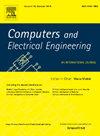Novel cascaded tilt fractional-order integral derivative with a proportional integral for harmonics mitigation in 31-level multi-level inverter
IF 4
3区 计算机科学
Q1 COMPUTER SCIENCE, HARDWARE & ARCHITECTURE
引用次数: 0
Abstract
Alternate current (AC) motor drives and distributed power generation systems often use inverters, which are also known as DC-to-AC power converters. Multi-Level Inverters (MLIs) have emerged as the preferred inverter technology due to their benefits of lower switching losses and improved harmonic profile. In this article, an innovative controller topology for reducing total harmonic distortion (THD) in the 31-level MLI is proposed. A cascaded controller consisting of tilt fractional order integral derivative with proportional integral controller (C-TFOID-PI) is proposed for optimizing the switching angles of the MLI. Green anaconda optimization algorithm (GAOA) is included in this work to select the optimal gain parameters in the novel controller with minimum error. A single-phase 31-level asymmetrical cascaded MLI is utilized in this work to validate the proposed controller with the optimization method. By simulating the entire procedure with MATLAB/Simulink, the control performance of the proposed system is verified. In order to demonstrate the superior performance of the proposed C-TFOID-PI controller and optimization method, its performance is contrasted with that of other controllers. The proposed controller topology effectively lowers the THD to 0.41 %, which is 2 % better than a fuzzy logic controller. Also, the proposed inverter topology improves efficiency by 3.9 % and reduces losses by 1.02 % when compared with other controllers.
基于比例积分的31电平多电平逆变器级联倾斜分数阶积分导数谐波抑制方法
交流(AC)电机驱动和分布式发电系统通常使用逆变器,也称为直流-交流电源转换器。多级逆变器(MLIs)由于其降低开关损耗和改善谐波分布的优点而成为首选的逆变器技术。本文提出了一种新颖的控制器拓扑结构,用于降低31电平MLI中的总谐波失真(THD)。提出了一种由倾斜分数阶积分导数与比例积分控制器组成的级联控制器(C-TFOID-PI),用于优化MLI的切换角度。本文采用绿蟒蛇优化算法(GAOA),以最小误差选择控制器的最优增益参数。本文利用一个单相31电平非对称级联MLI来验证所提出的控制器的优化方法。通过MATLAB/Simulink对整个过程进行仿真,验证了系统的控制性能。为了证明所提出的C-TFOID-PI控制器及其优化方法的优越性,将其性能与其他控制器进行了对比。所提出的控制器拓扑有效地将THD降低到0.41%,比模糊逻辑控制器高2%。此外,与其他控制器相比,所提出的逆变器拓扑提高了3.9%的效率,减少了1.02%的损耗。
本文章由计算机程序翻译,如有差异,请以英文原文为准。
求助全文
约1分钟内获得全文
求助全文
来源期刊

Computers & Electrical Engineering
工程技术-工程:电子与电气
CiteScore
9.20
自引率
7.00%
发文量
661
审稿时长
47 days
期刊介绍:
The impact of computers has nowhere been more revolutionary than in electrical engineering. The design, analysis, and operation of electrical and electronic systems are now dominated by computers, a transformation that has been motivated by the natural ease of interface between computers and electrical systems, and the promise of spectacular improvements in speed and efficiency.
Published since 1973, Computers & Electrical Engineering provides rapid publication of topical research into the integration of computer technology and computational techniques with electrical and electronic systems. The journal publishes papers featuring novel implementations of computers and computational techniques in areas like signal and image processing, high-performance computing, parallel processing, and communications. Special attention will be paid to papers describing innovative architectures, algorithms, and software tools.
 求助内容:
求助内容: 应助结果提醒方式:
应助结果提醒方式:


